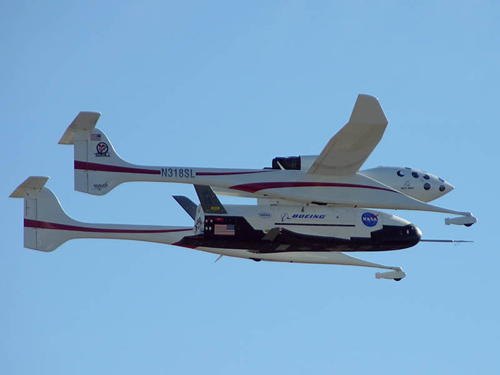X-37 Flies At Mojave But Encounters Landing Problems

Arobotic space plane was dropped today at high altitude, touching down underautonomous control, but encountered difficulties on landing and rolled off theend of a runway.
Afterseveral attempts, weather and technology merged today for a successful droptest of the X-37, a project of the Pentagon's Defense Advanced ResearchProjects Agency (DARPA) and the Space and Intelligence division of the BoeingCompany, with limited support from NASA.
Accordingto Boeing spokesman, Joe Tedino, the DARPA-sponsored X-37 Approach andLanding Test Vehicle (ALTV) did conduct its first drop test today.
TheALTV successfully executed its autonomous landing profile, Tedino told SPACE.com,"but the vehicle experienced an anomaly after touchdown at Edwards Air ForceBase, California and departed the end of the runway. The ALTV flight teamis assessing the situation and reviewing test data. No further informationis available at this time."
Nosegear heavily damaged
A DARPAstatement on the test flight was issued late today to SPACE.com.
Accordingto Jan Walker of DARPA External Relations the White Knight and ALTV took offfrom the Mojave, California airport at 6:30 a.m. Pacific Daylight Time (PDT).At 7:28 a.m. PDT, White Knight released ALTV within the Edwards Air Force Basetest range airspace at an altitude of 37,000 feet.
Breaking space news, the latest updates on rocket launches, skywatching events and more!
Afterrelease, the ALTV touched down on runway 22 at Edwards AFB at 7:31 a.m. PDT.
"ALTV'sautonomous landing sequence and initial touch-down were flawless and fullyaccording to plan," Walker reported, "but ALTV did not stop in the distanceexpected and rolled off the end of the runway. ALTV's steering was nominal forthe full length of the runway."
The causeof the incident is not yet known, with the ALTV flight team now engaged inassessing the situation, Walker said.
"All flightdata has been recovered from ALTV. There was minor damage to ALTV--the noselanding gear is heavily damaged but the main landing gear and aircraft appearstructurally intact," Walker explained in the statement.
White Knight mothership
Theearly morning drop of the unpiloted X-37 took place high above the desertlandscape in the Mojave, California area. The drop took place at about 37,000feet, accomplished by taking the space plane skyward, tucked underneath theScaled Composites White Knight carrier plane.
WhiteKnight is operated by Scaled Composites of Mojave, California--the pioneeringfirm that used the same mothership to tote SpaceShipOne to altitude forrelease. It was SpaceShipOne, also designed by the firm that snagged the $10million Ansari X Prize by back-to-back piloted suborbital flights in 2004.
Therobotic space plane is classed by DARPA as the Approach and Landing TestVehicle and has been at the inland spaceport in Mojave, California sincemid-April of last year.
TheWhite Knight/X-37 mated combination has undergone a series of taxi and flighthops in preparation for today's first release of the vehicle. But the craft'sfirst drop test was plagued several times by local bad weather, as well astelemetry issues between the vehicle and ground controllers.
Early NASA plans
Inthe late 1990s, the X-37 was a NASA-sponsored project--part of a planned seriesof flight demonstrators dubbed Future X.
Atthat time, the Boeing-built X-37 was advertised as an unpiloted, autonomouslyoperated vehicle designed to conduct on-orbit operations and collect test datain the Mach 25 (reentry) region of flight.
Earlyplans for the X-37 called for it to be ferried to orbit by the space shuttle ora throw-away launch vehicle. Once free in Earth orbit, the craft would remainin space for up to 21 days, carrying out a variety of experiments beforereentering the atmosphere and landing on a conventional runway.
Thoseplans were eventually cancelled, with NASA transferring its X-37 technologydemonstration program to DARPA in late 2004.
NASAdetermined that the X-37 ALTV did not meet the goals of the Vision for SpaceExploration and as a result transferred the program to DARPA. NASA's only rolein the drop tests is as a technical advisor, despite the large NASA logo on thevehicle.
- Technology Twosome: High-flying at Mojave
- The X-37 Spaceplane to Fly At Mojave Spaceport
- White Knight Prepares For New Mission
- NASA Transfers X-37 Project to DARPA

Leonard David is an award-winning space journalist who has been reporting on space activities for more than 50 years. Currently writing as Space.com's Space Insider Columnist among his other projects, Leonard has authored numerous books on space exploration, Mars missions and more, with his latest being "Moon Rush: The New Space Race" published in 2019 by National Geographic. He also wrote "Mars: Our Future on the Red Planet" released in 2016 by National Geographic. Leonard has served as a correspondent for SpaceNews, Scientific American and Aerospace America for the AIAA. He has received many awards, including the first Ordway Award for Sustained Excellence in Spaceflight History in 2015 at the AAS Wernher von Braun Memorial Symposium. You can find out Leonard's latest project at his website and on Twitter.
